Sergeant Majors
Abudefduf saxatilis
Sergeant Majors are a species of Damselfish.
The name comes from the military stripes on its body.
They will nest in schools with the males guarding the eggs.
Although only about 6 ins long they will aggressively protect their nests and have been known to nip at divers and attack their masks
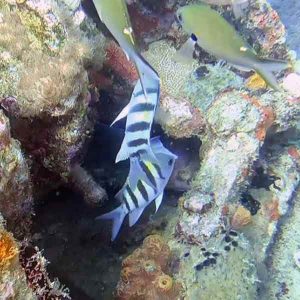
Smallmouth Grunts
Haemulon chrysargyreum
On the video we have a mix of French and Smallmouth Grunts.
Smallmouth Grunts are the fish with the distinctive yellow stripes, also known as the “Yellowstripe Grunt”.
Growing up to about 10 ins long, they are often caught as “bait fish” by fisherman.
These grunts during daytime live in schools near reefs, rocks or inside wrecks and then go out at night to feed at the open sea.
Smallmouth Grunts feed mainly on plankton but also small crustaceans and other mollusks.
There are also a few small Yellowtail Snappers mixed in with these shoals of Grunts.
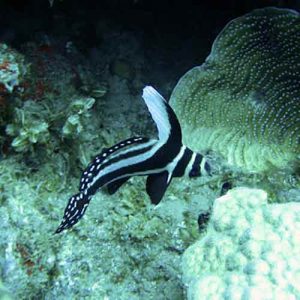
Southern Stingray
Hypanus americanus
Southern Stingrays are a whiptail ray. The long slender tail possesses a serrated and venomous spine at the base. Not fatal but incredibly painful. The barb is used for defensive purposes.
They feed on shellfish, worms shrimp and other small creatures on the sandy bottom. They blow water out through their mouth and flap their “wings” during the feeding process. The sand displaced then settles on their body, they use the same process to camouflage themselves on a sandy seabed.
Mature adults can reach five feet (1.5m) wide with a tail that is even longer.
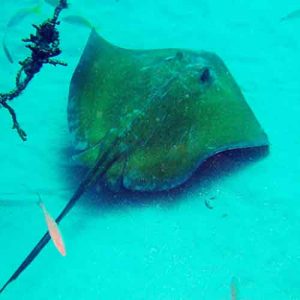
Smooth Trunkfish
Lactophrys triqueter
Smooth Trunkfish are a member of the Boxfish family.
About 9 ins long is a good size, but they can grow larger.
The body is a triangle shape and is covered in plate-like scales that are very tough.
When feeding it puffs jets of water out from its protruding lips to disturb invertebrates in the sand, here you see it feeding on sponges.
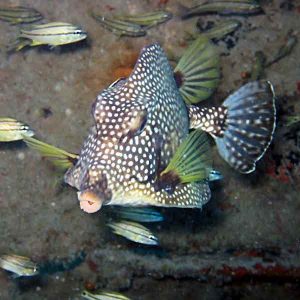
Spiny Lobster
Panulirus argus
The Caribbean Spiny Lobster has no claws but has 2 large whip like antennas for defense.
The upper part of the body is also covered with sharp spines.
This lobster is probably the most important commercial species in the Caribbean.
As they grow, lobsters shed their exoskeleton to make room for their larger bodies.
Lobsters will feed on anything dead they find at the bottom of the ocean along with Mollusks (small invertebrates) and plant material.
A good size lobster can grow up to 2 ft long in the body, that’s over 4 ft from the tip of the antennae to the tail.
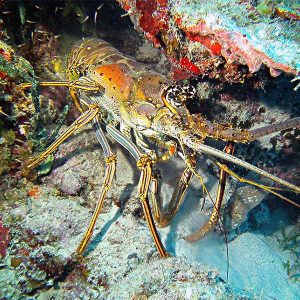
Spotted Drum
Equetus punctatus
The Spotted Drum also known as a High Hat grows up to about 10 inches long. They feed nocturnally on crabs, shrimps and worms.
Spotted Drum are solitary fish, hanging out wherever cover can be found.
Drums are named for the repetitive throbbing or drumming sounds they make by beating their abdominal muscles against their swim bladder.
The Juvenile Spotted Drum is a very unusual crescent shape.
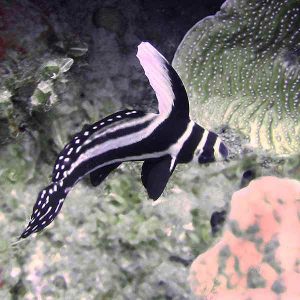
Spotted Moray
Gymnothorax moringa
Spotted Morays are also known as Speckled Morays and Congers.
The long snake-like body can grow up to 6 ft in length.
These are solitary animals, hiding in cracks on the reef or inside wrecks.
The constant opening and closing of the mouth is to keep water circulating over the gills.
Moray eels have 2 jaws, each has a set of teeth. When the moray captures prey, it first bites normally with its oral jaws, holding the prey. Then the pharyngeal jaws are brought forward and bite down on the prey to grip it; they then retract, pulling the prey down the moray eel’s gullet, allowing it to be swallowed.
The Moray at the end of this video gets far too close for comfort!
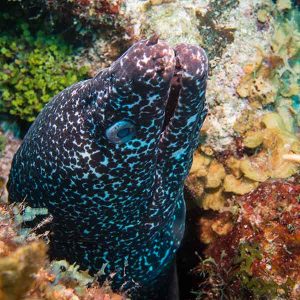
Squirrelfish
Holocentrus adscensionis
This Squirrelfish is one of about 150 species of Squirrelfish.
It has large eyes and the long third spine of the anal fin.
Growing to about 12 inches long, it is territorial in its crevices during the day and emerges to feed at night.
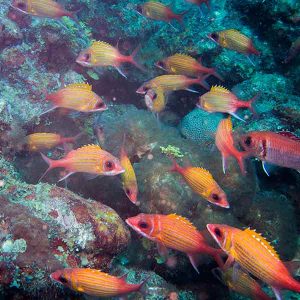
Trumpetfish
Aulostomus strigosus
The Atlantic Trumpetfish are large reef fish and can reach 3 ft in length. A carnivorous fish, they hover motionless above their prey and then quickly dart in creating suction in their jaws which takes the prey straight into their mouth.
They conceal themselves by floating in a vertical head-down position among the corals. The Trumpetfish can change its color very quickly to match its surroundings or the prey it is stalking!
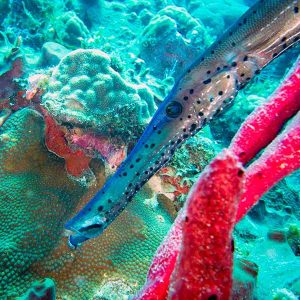
Tubeworms
Sabellidae
A Tubeworm is an invertebrate that anchors its tail to the reef and secretes around its body a mineral tube, into which, when threatened, it can withdraw its entire body.
Tubeworms do not eat, they allow bacteria to live inside them which provides their nourishment.
These are examples of Feather Duster Tubeworms.
Watch the worm retract into its tube at the end of the video.

Yellowline Arrow Crab
Stenorhynchus seticornis
Yellowline Arrow crabs are a small spider crab.
With its tall triangular body and long legs they are often confused with sea spiders.
This crab can be found hidden under ledges, sea fans, and on sponges.



